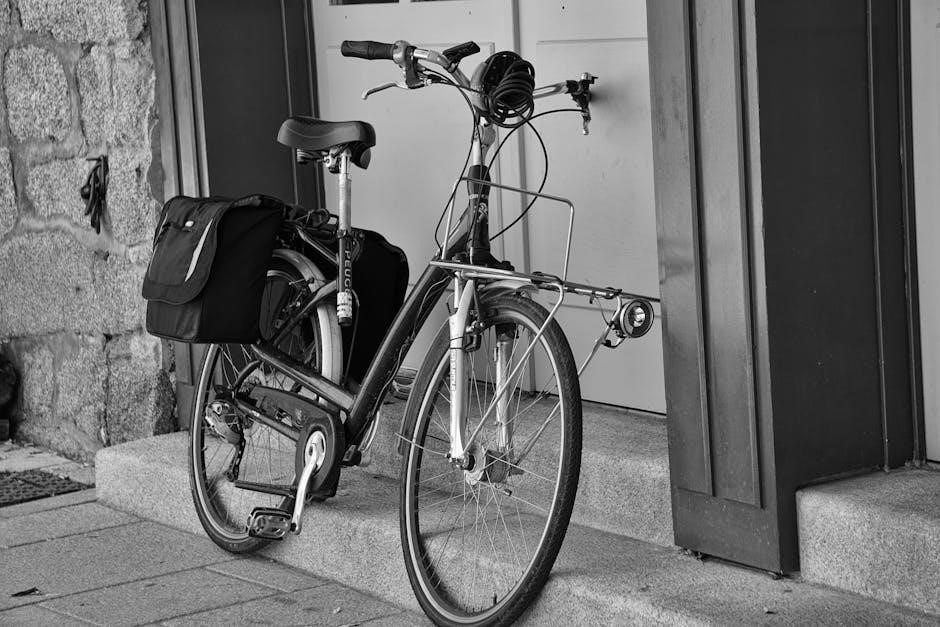saddle fitting guide
Saddle fitting is a critical aspect of horse care, ensuring comfort and performance for both horse and rider. Proper fit prevents discomfort, injury, and affects horse behavior. A well-fitted saddle promotes balance, even weight distribution, and freedom of movement. Saddle fitters play a key role in educating horse owners on optimal fit, while regular checks and adjustments are essential for maintaining horse welfare and riding efficiency.
Importance of Proper Saddle Fit for Horse and Rider
Proper saddle fit is essential for the health, comfort, and performance of both the horse and rider. A poorly fitted saddle can cause discomfort, injury, or restricted movement for the horse, potentially leading to long-term issues. It may also result in behavioral problems, such as resistance or unwillingness to perform. For the rider, an ill-fitting saddle can hinder balance, control, and communication with the horse, affecting overall riding effectiveness. Ensuring a correct fit promotes even weight distribution, prevents pressure points, and allows the horse to move freely. Regular saddle checks and adjustments are vital to maintain optimal comfort and performance for both partners, fostering a stronger horse-rider connection and enhancing overall equestrian experience.
Overview of the Saddle Fitting Process
The saddle fitting process involves a comprehensive assessment to ensure optimal fit for both horse and rider. It begins with evaluating the horse’s anatomy, particularly the withers and back conformation, to determine the appropriate saddle tree size and style. Next, the saddle is examined for balance, weight distribution, and compatibility with the horse’s shape. A trained fitter may use tools or templates to guide the process. The horse is observed both stationary and in motion to ensure the saddle moves harmoniously with its body. Adjustments may be made, and additional accessories like pads or half-pads can be recommended for correction. Professional consultation is often sought for complex cases, ensuring the final fit maximizes comfort, performance, and long-term well-being for the horse and rider.
Understanding Horse Anatomy for Saddle Fitting
The withers, spine, and back muscles are key anatomical features influencing saddle fit. Proper alignment ensures comfort, prevents pressure points, and supports the horse’s natural movement and posture.
The Role of the Wither in Saddle Fit
The withers, the bony prominence at the base of the horse’s neck, play a crucial role in saddle fit. They provide the primary point of contact for the saddle and help distribute the rider’s weight. Proper clearance between the saddle and the withers is essential to prevent pressure points and discomfort. A saddle that sits too low or presses on the withers can restrict the horse’s movement and cause pain. The withers’ height and shape vary among horses, so measuring them accurately ensures a well-fitting saddle. Improper fit can lead to behavioral issues, poor performance, and long-term health problems for the horse. Regular checks and adjustments are necessary to maintain optimal comfort and support.
Horse Conformation and Its Impact on Saddle Fit
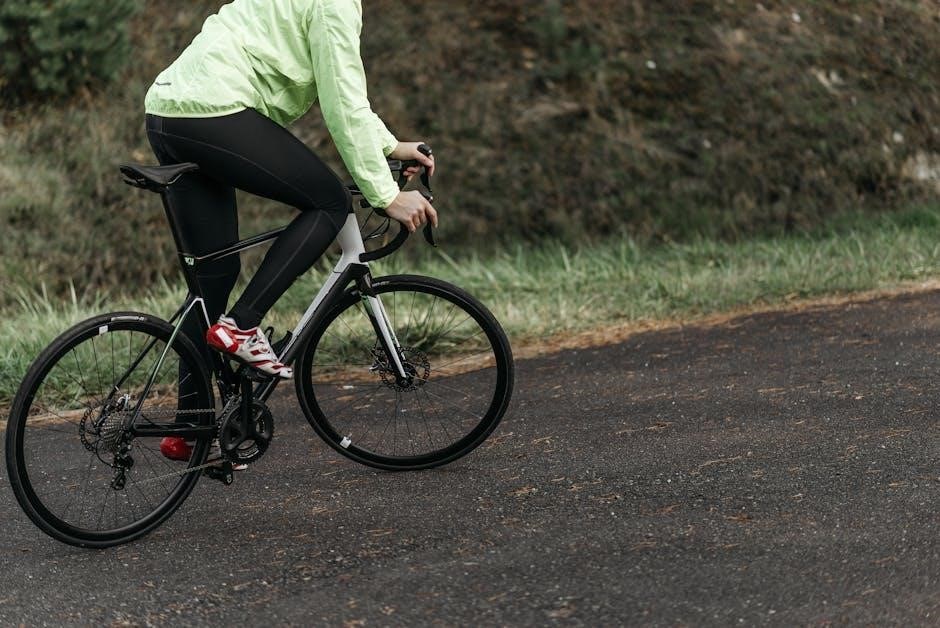
Horse conformation, the overall structure and proportions of the horse’s body, significantly influences saddle fit. Variations in back length, wither height, and shoulder angle affect how a saddle rests on the horse. A horse with a long, straight back may require a different saddle than one with a shorter, more compact back. Additionally, the shape and muscling of the horse’s back influence the fit, as some saddles are designed for specific body types. Changes in conformation due to age, training, or health can alter saddle fit over time. Understanding a horse’s unique conformation is crucial for selecting a saddle that promotes comfort and prevents discomfort or injury. Regular assessments ensure the saddle remains suitable as the horse’s body evolves.
How Horse Movement Affects Saddle Fit
Horse movement plays a critical role in saddle fit, as motion can cause the saddle to shift or exert uneven pressure. During locomotion, the horse’s back muscles flex and expand, which can alter the fit of a static saddle. The dynamic nature of the horse’s movement means the saddle must accommodate these changes without restricting movement or causing discomfort. Gaits, such as trot or canter, can magnify issues like saddle slipping or bridging if the fit is not optimal. Proper saddle fit ensures even weight distribution and freedom of movement, while poor fit can lead to discomfort, behavior issues, or performance problems. Regular evaluation during motion is essential to maintain optimal fit and comfort for the horse.

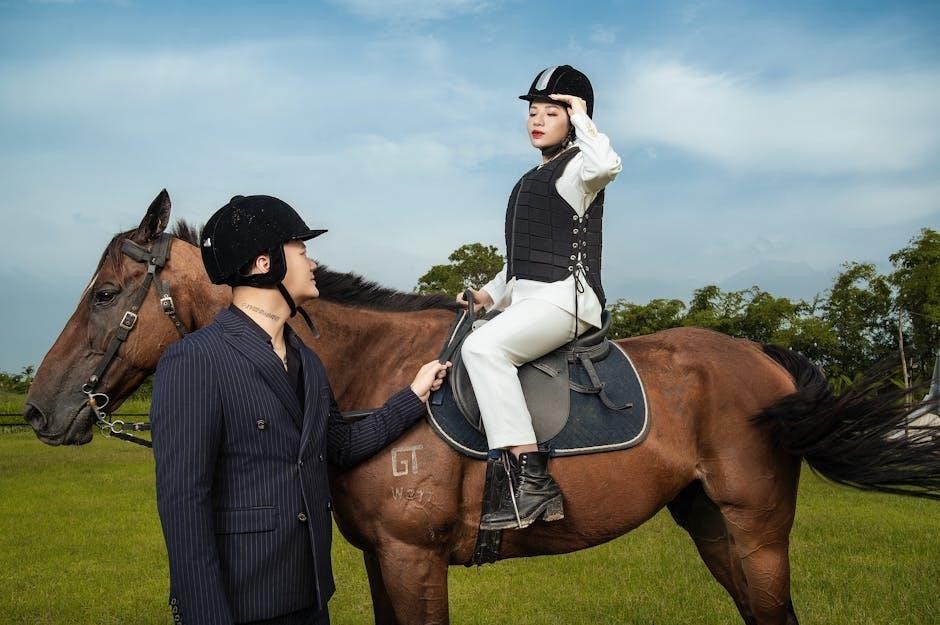
Evaluating the Saddle
Evaluating the saddle involves inspecting its condition, fit, and functionality. Check for wear, damage, and proper alignment with the horse’s anatomy to ensure optimal fit and comfort.
Types of Saddles and Their Purposes
Understanding the different types of saddles is crucial for ensuring proper fit and functionality; English saddles, such as dressage, show jumping, and all-purpose saddles, are designed for specific disciplines, emphasizing precision and mobility. Dressage saddles feature a deeper seat and longer flaps to support the rider’s position, while show jumping saddles are lighter with a more forward-cut flap for freedom of movement. Western saddles, including reining, barrel racing, and trail saddles, are built for comfort during long rides and often include a prominent horn for roping. Each saddle type is tailored to the rider’s needs, the horse’s anatomy, and the specific demands of the discipline, making it essential to choose the right style for optimal performance and comfort.
Assessing Saddle Tree Size and Style
The saddle tree, the internal framework of the saddle, plays a critical role in fit and comfort. It must match the horse’s anatomy to avoid pressure points. Trees come in various sizes, such as narrow, medium, or wide, and styles, including straight or curved. The tree size should align with the horse’s ribcage shape and wither width. A properly fitted tree ensures even weight distribution and prevents restriction of the horse’s shoulders or spine. The tree style also influences the saddle’s balance and clearance over the withers. Incorrect tree size or style can lead to discomfort, poor performance, or long-term damage to the horse. Always assess the tree in relation to the horse’s conformation for optimal fit.
Checking Saddle Balance and Even Weight Distribution
Saddle balance and weight distribution are crucial for both horse and rider comfort. A well-balanced saddle ensures the weight is evenly distributed across the horse’s back, preventing pressure points. To check balance, place the saddle on the horse without a pad and observe if it sits level. The pommel and cantle should be parallel to the ground. Uneven distribution can cause the saddle to tip, leading to discomfort and restricted movement. Proper balance also supports the rider’s position, allowing them to maintain equilibrium. Always ensure the saddle is centered and evenly weighted to promote optimal performance and prevent long-term issues for the horse. Regular checks are essential to maintain proper fit and function.
Assessing Saddle Fit on the Horse
Proper saddle fit ensures the horse’s comfort and performance. Regularly check how the saddle sits on the horse’s back, ensuring clearance around the withers and spine. Even weight distribution is key to prevent pressure points, allowing the horse to move freely. The saddle should stay in place during movement without shifting or causing discomfort. A well-fitted saddle supports the rider’s position while maintaining the horse’s natural posture and range of motion. Always assess fit dynamically, as the horse’s shape and needs may change over time, requiring adjustments for optimal comfort and function.
Clearance of the Wither and Spine
Ensuring proper clearance of the wither and spine is crucial for the horse’s comfort and long-term well-being. The saddle should sit above the withers, allowing at least 2-3 fingers of space to prevent pressure. The spine must not be compressed or rubbed by the saddle panels, as this can lead to pain and restricted movement. Improper clearance may cause discomfort, leading to behavioral issues or performance problems. Always check the fit dynamically, as the horse moves, to ensure the saddle does not shift and impinge on these sensitive areas. Correct clearance promotes proper posture, reduces the risk of injury, and enhances the horse’s ability to move freely and efficiently. Regular assessments are essential to maintain optimal fit and comfort.
Ensuring Proper Saddle Pad Usage
Proper saddle pad usage is essential for optimizing comfort, protection, and performance. The pad should be selected based on the horse’s specific needs, ensuring it fits correctly under the saddle without bunching or shifting. It should be thick enough to provide adequate cushioning but not so thick that it interferes with the saddle’s fit. Place the pad squarely on the horse’s back, smoothing it to eliminate wrinkles. High-quality materials, such as wool or gel, are recommended for their ability to wick moisture and distribute pressure evenly. Regularly clean and maintain the pad to prevent dirt and sweat buildup, which can cause discomfort. Always ensure the pad complements the saddle fit rather than compensating for poor fit. Professional guidance can help determine the best pad for your horse’s anatomy and your riding discipline.
Checking for Saddle Bridging or Gapping
Checking for saddle bridging or gapping is crucial to ensure proper fit and prevent discomfort or injury. Bridging occurs when the saddle lifts at the center, creating pressure points on the horse’s back, while gapping happens when the saddle sits too low, failing to make consistent contact. To inspect, place the saddle on the horse without a pad and observe its alignment. The saddle should rest evenly, with no visible gaps or lifted areas. Run your hand under the saddle to feel for consistent contact. If bridging or gapping is detected, it may indicate a poor fit or improper sizing. Adjustments or a professional fitting may be necessary to resolve these issues and ensure optimal comfort and performance for both horse and rider.
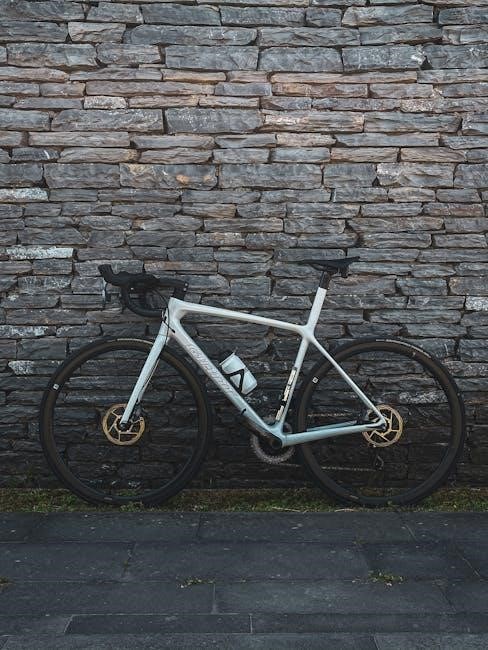
Rider Considerations in Saddle Fit
The rider’s weight, position, and balance significantly impact saddle fit, affecting both comfort and performance. Ensuring proper fit for the rider is essential to maintain harmony with the horse.
How Rider Weight and Position Affect Saddle Fit
The rider’s weight and position play a crucial role in saddle fit. A heavier rider may require a sturdier saddle tree and additional padding to prevent pressure points. Conversely, a lighter rider may need a more streamlined design to avoid excess material. Proper rider position ensures even weight distribution, preventing the saddle from shifting or causing discomfort. For example, a rider sitting too far back can cause the saddle to bridge, while leaning forward may lead to gapping. Discipline-specific positions, such as dressage or jumping, also influence saddle fit, as they demand different balances and supports. Regular adjustments are essential to accommodate changes in the rider’s weight or riding style.
Importance of Rider Balance and Comfort
Rider balance and comfort are essential for effective communication between horse and rider. A well-fitted saddle ensures the rider maintains proper posture, preventing strain and fatigue. The saddle’s design should support the rider’s natural position, allowing free movement in the seat and legs. Poor balance can lead to discomfort, affecting the rider’s ability to guide the horse. Adequate padding and a supportive seat help distribute weight evenly, reducing pressure points. A comfortable rider is better able to focus on performance, enhancing overall riding quality. Ensuring balance and comfort also minimizes the risk of injury and promotes a harmonious partnership between horse and rider, making it a critical aspect of saddle fit.
Adjusting the Saddle for Different Riding Disciplines
Adjusting the saddle to suit specific riding disciplines ensures optimal performance and comfort for both horse and rider. For disciplines like dressage, saddles are designed with a deeper seat and longer flaps to support a more upright position. Jumping saddles feature forward-cut flaps and a more compact design to accommodate shorter stirrups. Endurance or trail saddles prioritize comfort over long distances, often with extra padding and a more relaxed fit. Each discipline requires precise adjustments to saddle position, padding, and overall structure to meet the unique demands of the activity. These modifications ensure the saddle complements the rider’s movement and the horse’s anatomy, preventing discomfort or interference during performance.
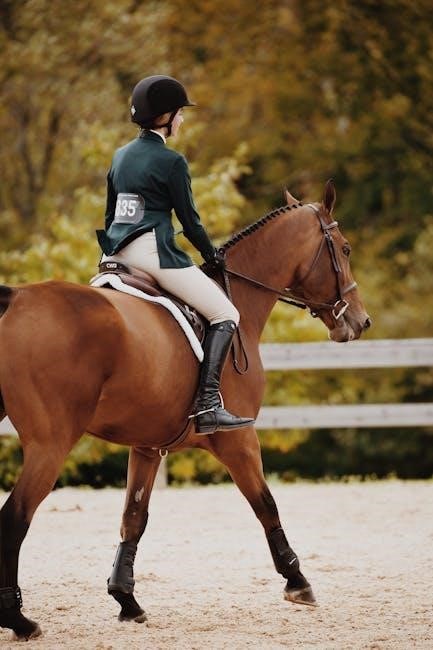
Measuring for the Perfect Fit

Accurate measurements ensure a saddle fits both horse and rider perfectly, promoting comfort and performance. Measure the horse’s back length, wither height, and rider’s seat and leg measurements. Use templates or professional guidance to confirm fit and avoid future issues.
Measuring the Horse for Saddle Fit
Measuring the horse is crucial for ensuring proper saddle fit. Start by assessing the horse’s back length, measuring from the base of the wither to the last rib. Use a flexible measuring tape or a wither gauge to determine the width across the withers. This helps identify the appropriate saddle tree size. Next, evaluate the horse’s back shape, noting any prominent muscles or curves. Measure the distance between the saddle support areas to ensure even weight distribution. Use a saddle fitting template to trace the horse’s back profile, which provides a visual guide for saddle selection. Always measure the horse on a level surface and with the saddle pad removed for accuracy. If unsure, consult a professional saddle fitter to ensure precise measurements.
Measuring the Rider for Optimal Comfort
Measuring the rider ensures the saddle accommodates their size and riding style. Start by measuring the rider’s seat size, which is determined by the distance between their sit bones. Use a seat gauge or a 20-inch ruler placed under the rider’s buttocks to find this measurement. Next, consider the rider’s height and weight, as these factors influence saddle balance and weight distribution. Taller or heavier riders may require a longer saddle flap or additional support. Measure the rider’s leg length to ensure proper stirrup placement, and assess their riding position (e.g., upright for dressage or forward for jumping). Finally, evaluate the rider’s comfort preferences, such as cushioning or seat depth. These measurements guide saddle selection for optimal comfort and performance. A professional fitter can help tailor the fit for the rider’s unique needs.
Using Saddle Fit Tools and Templates
Using saddle fit tools and templates is crucial for achieving an optimal fit for both horse and rider. Tools like wither gauges, flexible curves, and saddle templates help measure the horse’s back shape and length. These tools provide precise measurements to match the saddle tree size and style. A wither gauge measures the height and width of the withers, while a flexible curve traces the horse’s back for template comparison. Saddle templates can be placed on the horse to check clearance and alignment. Additionally, digital tools and apps are now available to streamline the process. Proper use of these tools ensures accuracy and helps prevent saddle-related issues. Always combine tool measurements with a visual assessment and professional guidance for the best results. Regular checks with these tools ensure long-term comfort and performance for the horse and rider.

Signs of Poor Saddle Fit
Poor saddle fit can cause visible pressure points, hair loss, or galling on the horse’s back. Behavioral signs include discomfort, reluctance to move, or unusual posture. Performance issues like reduced stride length, unwillingness to jump, or poor transitions may also arise. Always monitor physical and behavioral changes to address saddle fit issues promptly.
Physical Indicators on the Horse
Recognizing physical indicators of poor saddle fit is crucial for maintaining the horse’s comfort and health. Signs include swelling, redness, or heat around the withers and back muscles. Hair loss, rubbed areas, or shiny spots where the saddle contacts the horse’s back are common. Muscle atrophy or uneven development may occur if the saddle restricts movement or distributes weight unevenly. The saddle may also cause the horse’s spine to become sensitive or lead to galling if it bridges or sits too far back. Proper saddle fit ensures clearance over the withers and even weight distribution to prevent these physical discomforts and potential long-term damage.
Behavioral Signs of Discomfort
Horses exhibiting behavioral discomfort due to poor saddle fit may show restlessness, reluctance to move, or unwillingness to transition. They might display pinning ears, swishing tails, or even rearing when saddled. Some horses become overly sensitive to the cinch or girth, while others may refuse to bend or respond to aids. These behaviors often stem from pain or restricted movement caused by an ill-fitting saddle. Paying attention to these signs is crucial for addressing saddle fit issues early, ensuring the horse’s comfort and performance. Ignoring such indicators can lead to more severe behavioral problems, physical harm, or a breakdown in the horse-rider partnership over time.
Performance Issues Linked to Saddle Fit
Poor saddle fit can significantly impair a horse’s performance, leading to issues like difficulty in achieving or maintaining a specific gait; Horses may struggle with lead changes or show a lack of impulsion, reducing their power and efficiency, especially during jumps or accelerations. Transition problems, such as hesitating or rushing, can also arise, making it challenging for the horse to respond smoothly to aids. Additionally, collecting the horse may become difficult due to discomfort or restricted movement caused by an ill-fitting saddle. These performance setbacks often stem from pressure points or limited mobility, highlighting the importance of proper saddle fit for optimal athletic ability and responsiveness.
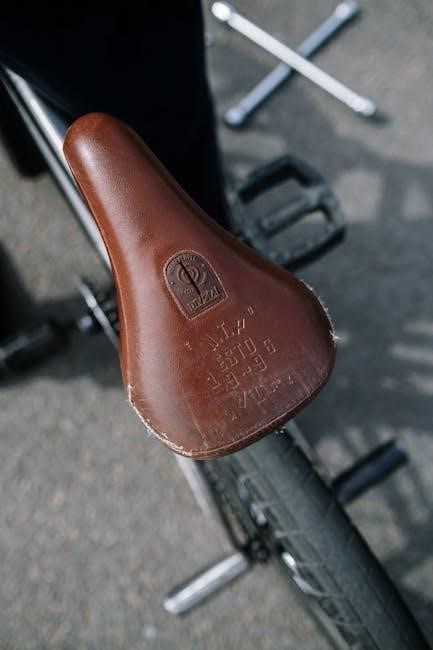
Troubleshooting Saddle Fit Issues
Identify and address saddle fit problems by assessing pressure points, gapping, or bridging. Regularly check for common issues like uneven wear or tree stress, ensuring proper adjustments. Professional guidance can resolve persistent discomfort or performance problems, optimizing both horse and rider comfort. Early detection prevents long-term damage, ensuring peak performance and well-being for the horse.
When to Adjust or Replace the Saddle
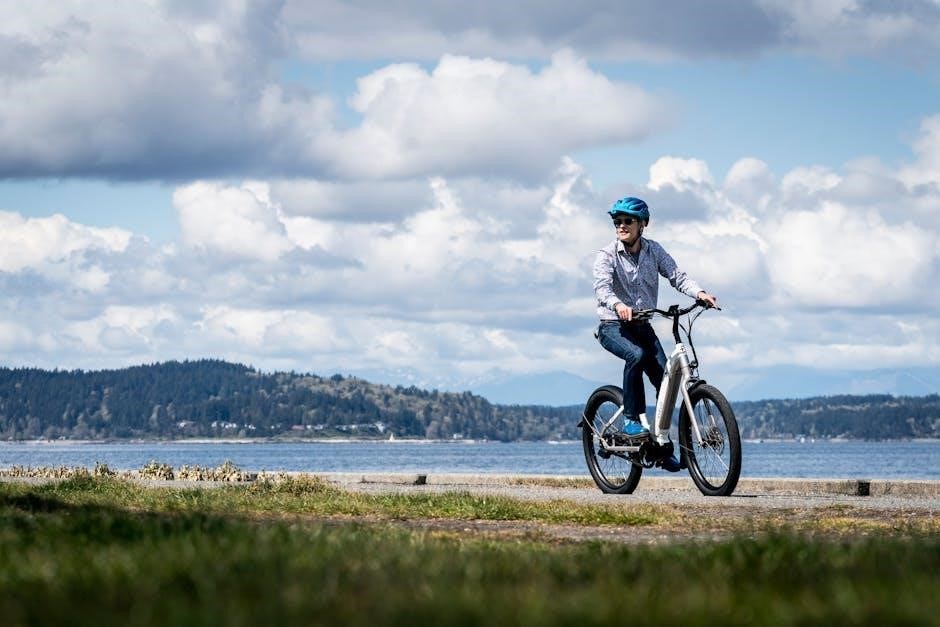
Determining when to adjust or replace a saddle is crucial for maintaining proper fit. If the saddle shows signs of wear, such as a warped tree or uneven flocking, replacement may be necessary. Significant changes in the horse’s condition, like weight gain or muscle development, often require adjustments. Similarly, if the rider’s needs evolve, such as switching disciplines, the saddle may need re-fitting or replacing. Persistent issues like gapping or bridging, despite padding, indicate a poor fit. Professional evaluation can help decide whether adjustments suffice or if a new saddle is needed. Regular monitoring ensures optimal comfort and performance for both horse and rider, preventing long-term discomfort or injury.
Using Saddle Pads or Half Pads for Correction
Saddle pads and half pads are valuable tools for addressing minor fit issues. They can compensate for unevenness, provide additional cushioning, or fill gaps between the saddle and the horse’s back. Gel or foam pads are popular for their shock-absorbing properties and ability to conform to the horse’s shape. Half pads, placed directly under the saddle, are ideal for correcting balance issues without adding bulk. However, pads should not be relied upon as a permanent fix for poor saddle fit. They are best used temporarily or in conjunction with a well-fitted saddle. Overusing pads can mask underlying problems, so it’s essential to ensure the saddle itself is correctly fitted before resorting to corrective padding.
Professional Saddle Fitting Consultation
A professional saddle fitter offers expertise to ensure optimal fit for both horse and rider. They use specialized tools, such as saddle templates and pressure mapping, to assess the horse’s anatomy and the saddle’s compatibility. A fitter will evaluate the horse’s conformation, movement, and the rider’s position to recommend the best fit. They can identify subtle issues that may not be obvious to the owner, such as uneven weight distribution or tree size mismatches. Professionals can also guide adjustments or suggest a new saddle if needed. Regular consultations are recommended to accommodate changes in the horse’s development or riding style, ensuring long-term comfort and performance. Their insights are invaluable for maintaining the well-being of the horse and enhancing the riding experience.
